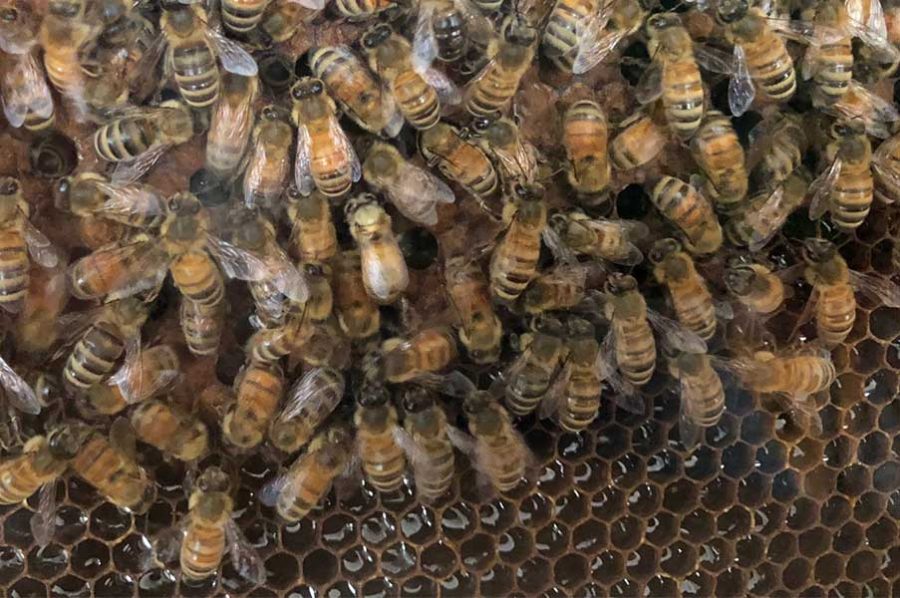To bee or not to bee … a beekeeper
October 9, 2018
During the Spring of 2018 Randy attended a beekeeping workshop at North 40. Only a couple weeks later he scored a sweet deal on five bee brood boxes. Not planning to start beekeeping until spring the following year he stacked them right outside the door to his shop. About two weeks later Randy came home from school one day to find a swarm of honey bees had moved into his boxes. A swarm can range between 20,000 and 30,000 bees. Randy’s was closer to 30,000. Randy explained this as inheriting and orphanage and knowing nothing about children.
Since then, and a 100+ hours later worth of youtube bee videos Randy has begun sharing his interest with many students and teachers at the Lake Pend Oreille High School. He brought an observation hive to school to give the students an idea of how the beehive works. An observation hive is just a frame or two taken out of the main hive, in a container so they can’t get out. Randy noticed how amused the students were. Our school counselor Deb who lives close by said he could put some hives at her place. He is now going to bring a nuc of bees to her house for interested students to be involved since it’s in walking distance. A nuc consist of a frame of honey, brood, worker bees and a queen. He’s going to write a grant to purchase some bee suits for the students to wear.
In every hive the bee members all have a specific job. The worker bees, the drones (male), and the queen. The queen bee is the largest bee in the colony. She lives up to 5 years. She is the the only one who can lay fertile eggs, and is also hatched from a fertile egg. On average, the queen will lay up to 2,000 eggs a day. Any egg the queen lays has the potential of becoming a queen bee, but only if fed with the right amount of royal jelly. Royal jelly is a milky secretion produced by worker bees entirely for the growth of their queen. Every egg the queen lays will hatch into a worker or drone bees unless turned into a new queen. But unless the queen disappears, dies, or on the verge of death, or preparing to swarm the worker bees will not grow another one. The queen bee relies on the worker bees for everything, including being fed, groomed and protected.
The worker bees are the smallest in the colony, living around 6 weeks in the summer. In the winter, they are referred as “winter bees”. Though you may hear some call them fat bees. They play a huge role in the hive. Worker bees do most of the work of feeding all the bees, maintaining the hive, and protecting the colony from intruders.Their lives surround the queen and the children. These bees can only lay infertile eggs, which will hatch nothing but drone bees. But unless the queen dies, the worker bees won’t lay any eggs. When the queen unexpectedly dies the worker bees will find eggs or larva less than 3 days old and house them vertically hanginging queen cells. But if left with no eggs laid by the queen, the hive will become a queenless colony and will become stressed and vulnerable to disease. The only way a beekeeper can save his colony without a queen is to introduce a new queen from outside the hive that the bees are willing to accept as their queen. Worker bees are normally the only ones to leave the hive to collect pollen and nectar which is fed to the growing larva. On certain occasions when the queen unexpectedly dies or disappears, Though these queens are typically smaller and weaker. With all the work the worker bees do, they normally die of exhaustion. Their existence is imperative for the hive’s existence and honey production.
The drones are the male honey bees in the hive, being bigger than the worker bees but smaller than the queen bee. Drones also do not have the ability to sting. These bees can be laid by either the queen or the worker bees since drone eggs aren’t fertile, but normally only the queen will lay all of the eggs. They always die upon mating and the other drones are expelled from the hive before winter, living anywhere from a couple weeks up to four months. The drones purpose is to be available to mate with a virgin queen. They don’t participate in gathering the pollen or raising the young. During the Summer when resources are plenty, the hive tolerates the drones not helping. As winter nears and resources are finite the drones are cast out of the hive and are left to die.
Many LPO students are looking forward to working with the bees at Deb’s, spring of 2019. Thanks to Randy, the interested students now get to experience working with honey bees and possibly have their own hives in the future.



